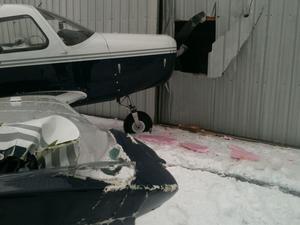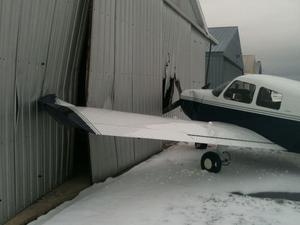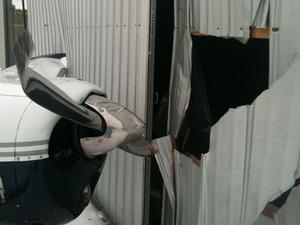More Autopilot Testing
- Details
- Written by Kevin Horton
- Hits: 3054
The weather was not too bad yesterday morning, so I zipped out to the airport for an RV-8 flight. I got an hour of engine break-in and autopilot testing done before some snow showers started to approach the airport. It wasn't clear how bad it was going to get, so I landed. It turned out that the snow never really hit the airport, but it is a lot better to be on the ground wishing you were flying than the other way around.
I tweaked the autopilot gains a bit more, and managed to make some improvement. It works well in level flight, and the altitude hold performance in turns is better than before. It still isn't working as well as I would like during climbs or descents, so I'll focus on that on the next flight.
I tested the automatic 180 degree turn mode, and that works well. It is designed for the case where you are flying VFR and inadvertently enter cloud. You press and hold the engage button for the lateral or vertical servo, and the autopilot executes a level 180 degree turn. The turn is to the left if you push the button for the lateral servo (which is on the left side of the control head), and it is to the right if you used the vertical servo button (on the right side of the control head). I hope to never need this mode, but it is a nice safety feature, assuming the pilot can remember how to engage a mode that he probably only ever used during the initial testing.
I'm finding the interface for the vertical modes confusing, just as I had expected from reading the manual. The basic operation is very simple - it always engages in altitude hold mode when you engage the vertical servo. This might not be what you want, but it is at least very predictable, and the active ALT HLD mode is clearly indicated on the control head. The confusion starts when you want to do a climb or descent to a selected altitude. You need to make just the right sequence of "V MODE" button pushes and rotary knob turns and pushes. If you get it right, the autopilot climbs or descends to the desired altitude. If you get out of sequence and push the rotary knob when you should be pushing the "V MODE" button, you cancel the climb or descent and go back to altitude hold mode. And, if you got it all right, the LEDs are flashing during the climb or descent. Most people would associate flashing with a problem, but not on this autopilot in this specific circumstance (the autopilot does use flashing to indicate a problem in other circumstances). This is definitely not a good user interface. I'm going to write up a Cheat Sheet and add it to my printed checklist.
I've got some ideas for clearer mode selection and indication logic, and I'll send them to the designers as suggested improvements after I have some more time using the autopilot.
Runaway Plane
- Details
- Written by Kevin Horton
- Hits: 4224
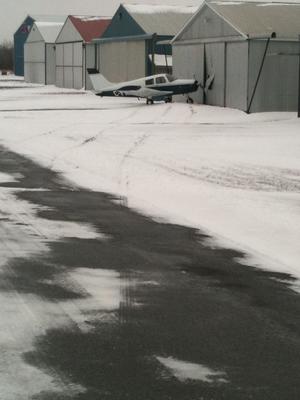 There was some excitement at CYSH yesterday. A Cherokee pilot was in front of his aircraft, moving the prop by hand before start (supposedly his aircraft won't start unless the prop is at the right angle). No one was in the aircraft, nor was it chocked. The engine started, the aircraft headed on down the taxiway and eventually hit a hangar door. Apparently an aircraft inside the hangar was damaged as well.
There was some excitement at CYSH yesterday. A Cherokee pilot was in front of his aircraft, moving the prop by hand before start (supposedly his aircraft won't start unless the prop is at the right angle). No one was in the aircraft, nor was it chocked. The engine started, the aircraft headed on down the taxiway and eventually hit a hangar door. Apparently an aircraft inside the hangar was damaged as well.
This is the same hangar line were I keep my aircraft. My aircraft is in the second last hangar, down towards the left side of the picture. There are advantages to being far away from the main ramp area.
No Weekend Flying
- Details
- Written by Kevin Horton
- Hits: 2532
I had hoped to get another flight off Saturday morning. The weather was looking not too bad - there was some precipitation north of the airport, but it seemed to be staying north. I drove to the airport, only to find that the runway was 100% ice covered. It had been quite cold for several days, but Saturday morning the temperature was just above freezing. The air was very moist, and I think the moisture was freezing on the cold runway. My car was sliding all over the place just driving around on the ramp, and there was a 90 degree crosswind, so I cancelled the planned flight. Today was a write-off, as we got hit by a nasty mix of snow, freezing rain and rain.
I've got a training simulator every day Monday thru Thursday, and a King Air proficiency flight all day on Friday. So, the next chance to go flying is next weekend.
Flying Again, Finally
- Details
- Written by Kevin Horton
- Hits: 2382
I finally got the RV-8 airborne again today. It's been ready to fly for almost a week, but every time the weather was suitable, I had to work, and the weather was terrible when I wasn't working. I was supposed to have a simulator session today, but the sim schedule got all scrambled, and that session couldn't happen. The weather forecast was not too bad, so I took a day of comp time.
I zipped out to the airport first thing this morning, only to find a fair bit of snow between the hangar and the taxiway. Fortunately, Ron, the hangar owner, has a snow blower in the hangar, so it only took about 20 minutes to get things cleared off.
I did another short engine run, then gassed up and flew for just over an hour, running at high power for the cylinder break-in. The engine appears to be working well.
I also did a bunch of autopilot testing, as this was the first flight since installing the Trio Pro Pilot autopilot. Its control was very sloppy at first, but I increased the gain in several incremental steps, and it was working quite a bit better by the end of the flight.
After landing, I pulled the cowlings to check for leaks, etc. There might be a tiny leak around the base of the new cylinder, or maybe that is just some of the oil we used during the assembly that is being squeezed out. I'll check again after a few more flights. There were also a few drops of oil in other places, completely unrelated to the cylinder change. Maybe the engine didn't like sitting for three months. I'll ignore these tiny leaks for the moment, in the hope that they will stop if I fly a bit more regularly.
After lunch, I flew for another hour, doing more cylinder break-in and autopilot testing. I fiddled with the gains some more, and got it working quite well when tracking the GPS flight plan in level flight. The vertical speed mode is still pretty sloppy as is capturing a selected altitude. The indicated airspeed mode has some pretty ugly porpoising. I'll tweak the gains some more on future flights to see if I can improve the performance of these modes. But, even if this is as good as it gets I am still happy, as the big thing I need is tracking of the GPS flight plan and altitude hold, and both of these seem to work very well. Vertical speed mode, indicated airspeed mode and capturing a selected altitude are "nice to have" extras.
No Test Flight Today
- Details
- Written by Kevin Horton
- Hits: 2479
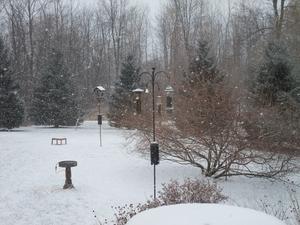 The weather looked pretty good at home mid-morning today, with broken cloud at about 2500 ft, and the ocassional snowflake falling. The radar showed some snow showers around Smiths Falls, but the Ottawa terminal forecast suggested the ceiling and visibility should be fairly good. I needed to put the cowling back on anyway, so I drove to the airport.
The weather looked pretty good at home mid-morning today, with broken cloud at about 2500 ft, and the ocassional snowflake falling. The radar showed some snow showers around Smiths Falls, but the Ottawa terminal forecast suggested the ceiling and visibility should be fairly good. I needed to put the cowling back on anyway, so I drove to the airport.
The ceiling and visibility at Smiths Falls was much worse than it was at home, and it didn't improve at all in the two hours I was there. I did get the cowling back on, but the radar suggested that the snow would continue for several hours, so I gave up any thought of flying today. By the time I got home it was snowing steadily there, as seen in the picture.
I am scheduled to fly a proficiency flight Monday afternoon on one of Transport Canada's aircraft. That aircraft was unserviceable on Friday - if it is still broke on Monday, and the weather is acceptable, I'll take the afternoon off and fly my aircraft instead.
Ready for Test Flight
- Details
- Written by Kevin Horton
- Hits: 3007
I got out to the hangar for a couple of hours one evening this week, and spent most of the day at the hangar today. I finished installing all the odds and ends back on the engine, and also finished the autopilot installation. I replaced a cracked flange on the right inlet air ramp where air for one of the heat muffs was sourced. I then spent a bunch of time figuring out why the battery charger wasn't working, eventually finding and fixing a short in its output harness.
I had hoped to get a test flight off today, but that didn't happen, as it took too long to get all the other odds and ends done. I did manage to do a short engine run, which confirmed no major leaks and that both plug were firing on the new cylinder. I might get the test flight done tomorrow, but the weather forecast is looking a bit shaky. We'll see what the weather gods bring.


